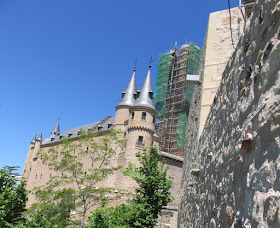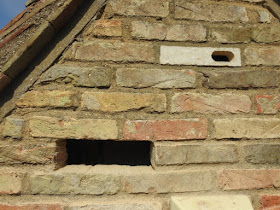This story was sent to us by Katherine Dubourg, volunteer and Vice President of the LPO PACA, in Toulon. It is the story of a concerned set of individuals who are doing something to reduce the destruction of Swifts' nests in Toulon. There may be ideas here for some members of the Swifts Local Network in the UK.
(Text translated by Jake Allsop)
SEASON 1: 2015
CENSUS OF COMMON SWIFT BREEDING SITES
As elsewhere throughout the Mediterranean coast, three species of swift are present in Toulon in the breeding season:
- Common Swift (Apus apus) is the most common and most abundant; it nests throughout the city.
- Pallid Swift (Apus pallidus) is rarer. In Toulon, it nests in the structures of the old port, in naval buildings, in the Bd de la République, and on the cliffs along the coast path.
- Alpine Swift (Apus melba) nests in the cliffs of Mont Faron and the coastal path.
 |
A Common Swift over Toulon
Photo André Schont (LPO PACA)
|
A Common Swift over Toulon
Photo André Schont (LPO PACA)
In Toulon, as almost everywhere else, mandatory renovation work is carried out every 10 years, but the restoration or rehabilitation of old buildings does not take account of the swifts' presence or their needs. Given that every single nesting cavity is filled in or destroyed, we were aware that the future of the birds was under threat.
And that is why the LPO PACA and its local volunteer group decided to act in Toulon to ensure that the protection and enhancement of this iconic species so closely associated with our built environment, should be implemented in all works of urban renewal.
In Toulon, which is the third city in the Provence Alpes Côte d'Azur region after Marseille and Nice, an ambitious urban renewal program of the historic centre has been ongoing for several years. There is a phased programme for the renovation of all districts, ranging from simple facade cleaning and restoration to demolition and reconstruction of entire blocks. And of course what concerns us is the risk of missing opportunities to provide compensatory nesting accommodation for swifts.
After two years of contacts and meetings, several City Hall services have responded, at first listening politely, then curious to know more, and finally showing great interest in the project. They include: Sustainable Development; Sustainable City; Protection of Wildlife; Urban Renewal; and Var Development Planning (A combined private and public consortium charged with the rehabilitation of the old centre of Toulon).
BREEDING CENSUS (May-June 2015).
Before a plan for protection can be formulated, it is necessary to gather precise information about the existing situation. For this purpose, a census of swift nesting sites in Toulon was proposed, which in turn led to a project involving a number of participants.
ACTIONS
- LPO PACA produced a leaflet "Campaign to census breeding Swifts in Toulon". About a thousand were distributed to residents, tourist offices, retailers, restaurants, schools and to various other public places. Some volunteers even went from door to door in the town centre to tell people about the reasons for the campaign.
- A conference on "Swifts in the Toulon Built Environment"was led by Katherine Dubourg. (Director LPO PACA) in Toulon.
- Katherine also participated in two radio programs on the swifts of Toulon and the Breeding Census Campaign 2015 (RCF and France Bleu Provence), France Bleu Provence also did a life outside broadcast on the arrival of the first swifts.
- In the end, nearly 30 people volunteered to participate in the original operation. And even though not everyone was available during the two months of the census, there were regularly between 5 and 12 people, getting out twice a week, on Mondays and Thursdays in late afternoon, near the Cafė Culture in the old city centre.
- Teams of 2-3 people were then formed. Armed with a section map* and a tally sheet**, they spent three hours with their noses in the air and their eyes open looking for and noting evidence of the birds' presence.
- * The local authority topography department kindly provided us with maps of the city showing streets and properties. The old center was divided into eight sectors.
- ** The tally sheet recorded the following information: the name or names of participants, weather, sector number, the name of the street, number of buildings, the property reference, the location of nest cavities or nests (eg 3rd pigeon hole to the left behind right gutter), times when birds observed entering or leaving cavity, and the number of A/R observed).
- After each survey, data were entered in an Excel spreadsheet, which was then submitted every weekend to the City Hall and to Var Development Planning.
- Once the survey was completed, all data were posted to http://www.faune-paca.org/
SUMMARY OF RESULTS
The census campaign ran from 21 May to 11 July 2015.
Although the Swifts are still present in the city in mid-July, most volunteers were exhausted. No more formal counts were done, but for some of us, observations continued until the end of September, especially for Pallid Swifts, which are the last to leave.
20 sessions of volunteer counting
250 hours of prospecting
384 active nests identified in the old center
In the old centre of Toulon, the majority of nests are in old pigeon holes (there are many old buildings in Toulon) on façades, behind guttering, under tiles and in the frameword of metal shutters, in delapidated walls of some historical monuments such as the Royal Tower, which is an historical monument at the entrance to Toulon harbor.
 |
| Location of nests in the Alexander Garden |
FOLLOW-UP IN 2016
The Mayor of Toulon in cooperation with LPO PACA has just published a leaflet: "Protection of Swifts in Toulon”, which will now be included by the Urban Planning Department in every future planning application (PIX credit: Swift Conservation). It is also at posted on the official website of the town hall:
http://toulon.fr/martinet
A meeting of the various stakeholders - buildings, businesses, architects, public and private donors - should be organized soon by Var Land Development and the City Council to ensure that everyone is made aware of the need for swift conservation in the city.
The Toulon Provence Méditerranée consortium (TPM) is committed to installing several temporary nest boxes on the site of the former Chalucet Hospital to provide accommodation for Swifts dislodged last year during demolition work. These will be installed before the birds arrive.
The Bouygues Immobilier company and ELAN Group carriers
http://cibi-biodivercity.com/biodivercity have also agreed to incorporate swift nestboxes in buildings in the Eco Font-Pré area which are currently under construction (800 homes of 30,000 m2).
For our part, LPO PACA and our volunteers will resume our surveys in several neighborhoods that were covered last year because lack of time, for example, the Montety district, which is part of a sprawling urban regeneration project. Forty swift nests were observed last year there in just three nights of observation.
A conference on Swallows and Swifts will be presented by Elise Cougnenc (LPO PACA) on Tuesday, March 30 at 17:45 at Peiresc Collège de Toulon tomark the beginning of SEASON 2 Swifts Toulon.
Katherine Dubourg
Vice President LPO PACA
Toulon
 |
| Installing a Schwegler treble box |












































